the place where Paleontology and Paleoanthropology meets Philately
2016
Paleontology and Paleoanthropology related Philatelic items of the year 2016
Dinosaurs and other prehistoric animals, fossils, fossil-found places, paleontologists and contributors to Paleontology and Paleoanthropology as well as Natural History Museums on stamps, postmarks and postal stationeries issued in 2016
Click on image to enlarge it or to be redirected to description page. Stamps on grey background are Undesired stamps
If you know about any other Philatelic item related to Paleontology or Paleoanthropology, issued this year which is not mentioned below, please inform me .
| <2017 | 2024, 2023, 2022, 2021, 2020, 2019, 2018, 2017, 2016, 2015, 2014, 2013, 2012, 2011, 2010, 2009, 2008, 2007, 2006, 2005, 2004, 2003, 2002, 2001, 2000, 1999, 1998, 1997, 1996, 1995, 1994, 1993, 1992, 1991, 1990, 1989, 1988, 1987, 1986, 1985, 1984, 1983, 1982, 1981, 1980, 1979, 1978, 1977, 1976, 1975, 1970-1974, 1960-1969, 1950-1959, 1840-1949 | 2015> |
Official stamps directly related to Paleontology: dinosaurs and other prehistoric animals, fossils, paleontologists
| 21.11.2016 Brazil | 29.10.2016 Moldova [6] | 12.10.2016 Croatia |
 |
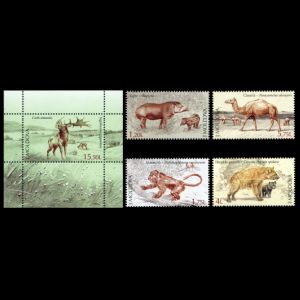 |
 |
| 20.09.2016 Gibraltar [5] | 26.08.2016 South African Republic | 30.06.2016 Spain |
 |
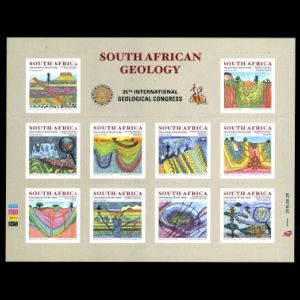 |
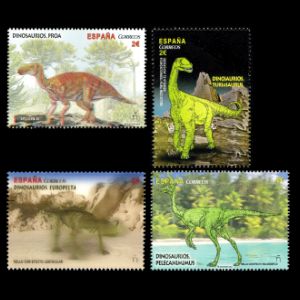 |
| 24.06.2016 Monaco | 08.06.2016 Hungary | 26.05.2016 Canada |
 |
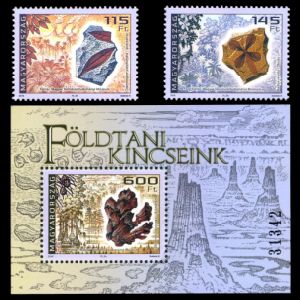 |
 |
| 26.05.2016 Canada | 25.03.2016 Slovenia | 23.02.2016 Serbia |
 |
 |
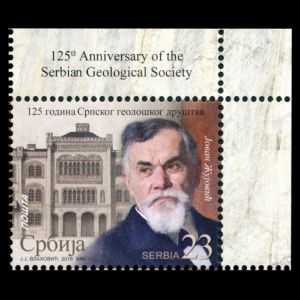 |
| 31.01.2016 Cuba [3] | 22.01.2016 Romania | 14.01.2016 Sweden |
 |
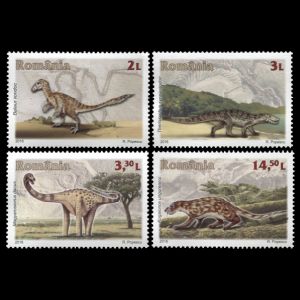 |
 |
|
Paleontology related stamps of countries who issue too many stamps per year,
stamps with prehistoric animals or their fossils without any relation to the issuing country
or stamps with inaccurate reconstruction of prehistoric animals.
These stamps are not recommended for serious collectors and are Undesired at serious philatelic exhibits, |
||
| Burundi [4] | Central African Republic | Djibouti |
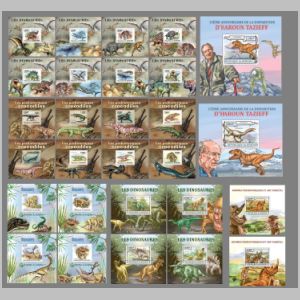 |
 |
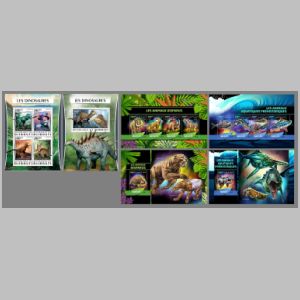 |
| Guinea | Guinea Bissau | Maldives |
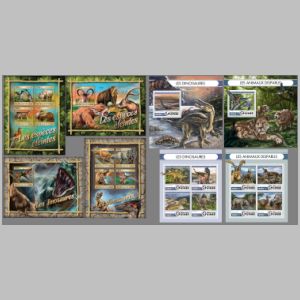 |
 |
 |
| Mozambique | Niger | São Tomé and Príncipe |
 |
 |
 |
| Solomon Islands | Sierra Leone | Togo [2] |
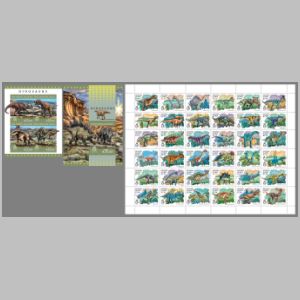 |
 |
 |
Notes:
[2] Two ammonites depicted on margins of "Shells" souvenir sheet.
[3] The issue was planned on 31.01.2016, but appeared on the market in middle of July 2016 only.
[4] In the middle of 2016 Stamperija announced "Special offer of various BURUNDI delux", these Deluxe-Sheets shows the same designs as Burundi's stamps issued between 2011 and 2013, includes dinosaurs and other prehistoric animals, when the country was a client of the company.

These are likely illegal and probably not recognized by Burundi’s Post.
[5] Gorham's Cave is a natural sea cave in Gibraltar, considered to be one of the last sites inhabited by Neanderthals in Europe. Gorham's Cave gives its name to the Gorham's Cave Complex, which is a combination of four distinct caves of such importance that they are combined into a UNESCO World Heritage Site.
Some Neanderthals are depicted on stamp with face value of 80p.
[6] Megolaceros giganteus shown on the block.
Megaloceros is an extinct genus of deer whose members lived throughout Eurasia from the late Pliocene to the Late Pleistocene and were important herbivores during the Ice Ages.
The largest species, Megolaceros giganteus, vernacularly known as the "Irish Elk" or "Giant Elk", is also the best known.
Dolichopithecus ruscinensis, shown on another stamp, is a prehistoric monkey from the Pliocene period (5.333 million to 2.58 million years ago).
Stamps of Local Post Authorities directly related to Paleontology: dinosaurs and other prehistoric animals
Note: These stamps were issued by not recognized self-governed or disputed territories, it can be used inside of the territories and in some cases even for international mail.However, according to the FIP regulations, issues of countries who are not recognized by the UPU are not allowed to be used at exhibitions organized or sponsored by the FIP.
The FIP recommends to collectors avoid these stamps at their collections.
| 18.03.2016 Transnistria | 25.06.2016 Transnistria (reprint) [L1] | |
 |
 |
|
Notes:
[L1] The stamp of Giganotosaurus is misspelled on the original issue, where it called Gigantosaurus.
Three months after issuing the stamp, the Post Authority of the un-recognized territory of Transnistria corrected the mistake.
Some personalized stamps directly related to Paleontology or Paleoanthropology: prehistoric animals, human ancestors and their fossils
| 19.05.2016 France [SP1] | 10.09.2016 Netherlands [SP2] | 2016 Germany [SP3] |
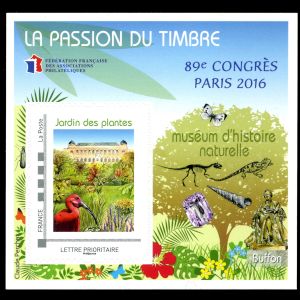 |
 |
 |
Notes:
[SP1] This Mini-Sheet was on sale between May 19 to 22 at Paris by Phil@poste for the French Federation of Philatelic Associations (FFAP) during the stamp show "La passion du timbre : Paris-Philex" and the 89th Congress of the FFAP. The stamp is a personalized one (1st national domestic rate); a Dinosaur skeleton, perhaps Tyrannosaurus rex, a gastropod fossil from the Tertiary (Turitella sp.), a cut amethyst crystal and Buffon's statue (located in the botanical garden of the Natural History Museum at Paris) are on the margin.
[SP2] Personalized stamps of Naturalis Biodiversity Center, were issued to commemorate "T rex in town" event that took place between September 10 and June 2017.
For more details, please go here.
[SP3] Personalized issue of private person to commemorate 160th anniversary of Neanderthal discovery in Germany.
Other stamps to consider
| 12.09.2016 Czech Republic [A9] | 02.06.2016 USA [A8] | 27.05.2016 Sierra Leone [A6] |
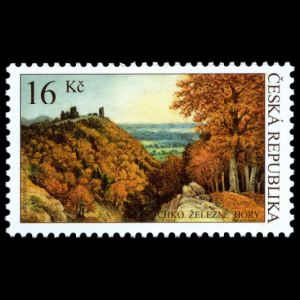 |
 |
 |
| 09.05.2016Estonia 09.05.2016 Serbia [A5] |
29.04.2016 Sierra Leone [A7] | 20.04.2016 Taiwan [A4] |
 |
 |
 |
| 07.04.2016 Germany [A3] | 30.03.2016 Falklands Islands [A2] | 18.03.2016 Guinea [A7] |
 |
 |
 |
| 09.03.2016 Liechtenstein [A1] | ||
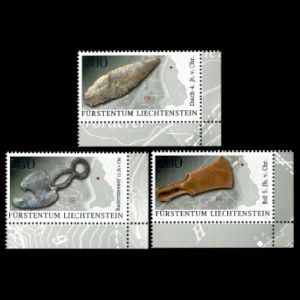 |
|
|
Notes:

|
| Flint tool on stamp of Liechtenstein 2016 MiNr.: , Scott: |

|
| The skull of Warrah from the Falkland islands on stamp Falkland islands 2016 MiNr.: , Scott: |
The dagger is important evidence of the trade relations that were conducted over long distances by the Neolithic inhabitants of the Alpine Rhine Valley.
For more details, please go here.
[A2] The Warrah (Falkland Islands wolf), depicted on stamp with face value of 1.01 GBP, was The Falklands only native land mammal.
Its existence in isolation on the Islands fascinated Charles Darwin (Darwin and a warrah is depicted on stamp Falklands island in 1982 and 2009 ) and to this day remains something of an enigma.
For more details, please go here.
[A3] The Moselle is a river flowing through France, Luxembourg, and Germany. It is a left-bank tributary of the Rhine, which it joins at Koblenz.
Moselle were formed between the Trier Valley and the Neuwied Basin.
The present source region of the Moselle, were formed about 50 million years ago. Many small marine fossils are found in the region. For more details, please go here.
[A4] NT$12 (number 4) of "Scenery Souvenir Sheet – Taitung County" souvenir sheet show the National Museum of Prehistory.
There are at least two permanent exhibits that belong to our topic: The Ice Age and Human Evolution. For more details, please go here.
[A5] This year, The Europa theme was “Ecology in Europe – Think Green”.

|
|
Human evolution on Europa Think Green stamps of Serbia and Estonia. Estonia MiNr.: 861 Scott: 814, Serbia MiNr.: 667 Scott: 741 |
[A6] On May 27 2016, Stamperija issued 18 Mini Sheets for Sierra Leone with the common subject "National Parks".
Two of them show East African Rift Valley, the Olduvai Gorge and the Turkana Lake on the map. All these places are well-known for their fossils of prehistoric humans.
[A7] Conrad Gessner was the first naturalist to write a book about fossils: "De omni rerum fossilium genere, gemmis, lapidibus, metallis, et huiusmod", published in 1565.
[A8] Carlsbad Caverns National Park, shown on one of the stamps.
The stamp image is a photograph by Richard McGuire of the interior of the caverns. High ancient sea ledges, deep rocky canyons, flowering cacti and desert wildlife are all treasures above and below the Chihuahuan Desert ground.
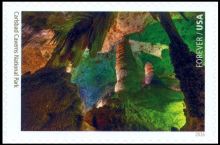 |
 |
| Carlsbad Caverns National Park fossil site on stamp of USA 2016, MiNr.: , Scott: | Ammonite on postmark of Czech 2016, MiNr.: , Scott: |
For more details, please go here.
[A9] Iron Mountains are the key to geological history of central Europe.
Proterozoic gneisses and volcano sedimentary complexes (subaerial and submarine volcanism) are present.
The earliest life forms have been found – stromatolites.
The third oldest ichnofossil of Zoophycos type in the world has been reported from this locality. Fossilized ammonite depicting on a postmark used for FDC.
For more details, please go here.
Attention: Fake / Illegal stamps !
An illegal stamp is defined by the Universal Postal Union (UPU) as a stamp that carries the name of a legitimate country or territory but was not produced or printed by the postal administration of that country and is not valid for postage anywhere in the world.| "stamps" of Dansolihon [F1] - Philippine | ||
 |
|
|
Notes:
[F1] These "Artist stamps" of Philippines's appeared on the Internet in 2016.
Dansolihon is a place with a very small population in the province of Cagayan de Oro, Philippines which is located in the continent/region of Asia.
These stamps are not official and they do not represent any official postal entity.
According to the seller they are "Artist stamps" - original "Art" item shaped like a stamp created by an artist or group of artists.
Commemorative Postmarks directly related to Paleontology and Paleoanthropology: dinosaurs and other prehistoric animals, fossils, human ancestors, paleontologists
Legend is here| 22.12.2016 Croatia [Sp] | 10.12.2016 Italy [Sp] | 21.11.2016 Brazil [FDC] [C8] |
 |
 |
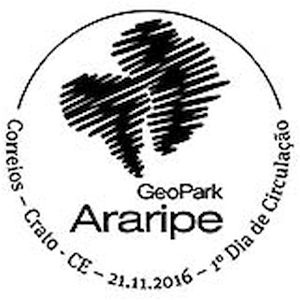 |
| 12.10.2016 Croatia [FDC] [C7] | 12.10.2016 Czech [FDC] | 19.07.2016 South Korea [Sp] [C6] |
 |
 |
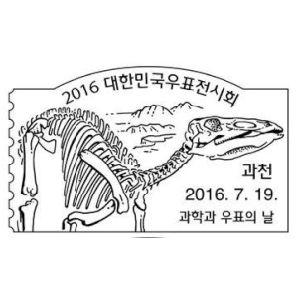 |
| 30.06.2016 Spain [FDC] | ||
 |
 |
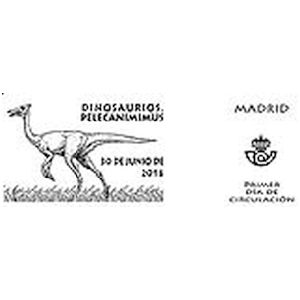 |
| 30.06.2016 Spain [FDC] | 24.06.2016 Monaco [FDC] [C5] | 08.06.2016 Hungary [FDC] [C4] |
 |
 |
 |
| 26.05.2016 Canada [FDC] [C3] | 06.05.2016 Germany [Sp] | 25.03.2016 Slovenia [FDC][C2] |
 |
 |
 |
| 22.01.2016 Romania [FDC] | 31.01.2016 Cuba [FDC] | 06.01.2016 Czech [Sp][C1] |
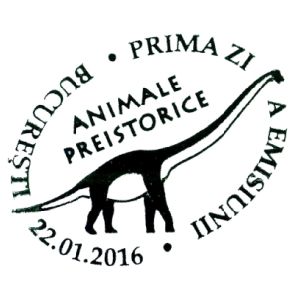
|
 |
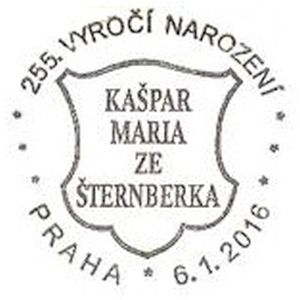 |
Notes:
[C1] Kaspar Maria von Sternberg (born on January 6th, 1761 at Brezina Castle) was one of the leading scientists of the first half of the 19th century, with a special interest in botany, geology and paleontology, and is considered one of the founders of paleobotany.
His portrait appeared on the postage stamp of Czech Republic in 2011. For more details, please go here.
[C2] Fossil of Cave Bear from FDC of "MAMMAL FOSSILS IN SLOVENIA" stamp of Slovenia.
[C3] Dinosaur footprints from FDC of "Dinos of Canada" stamps set of Canada.
[C4] Prehistoric plant from FDC of "Hungary’s Geological Treasures" stamps set of Hungary.
[C5] Flint tool and fossil of small goat, exactly as depicting on "Centenary of excavations at exotic Garden Cave" stamp of Monaco.
[C6] Edmontosaurus skeleton from the Gwacheon National Science Museum in South Korea.

[C7] Skull of "The lion of Dramalj" - Panthera leo fossilis from FDC of "Paleontology" stamps set of Croatia.
[C8] Stylized outline from a part of the Pangaea, a supercontinent that formed ~335 million years ago and started breaking up ~200 million years ago, connected with South America and Africa from FDC of "Geopark Araripe" stamp from Brazil.
Post stationary and Special Covers related to Paleontology: fossils, paleontologists, contributors to Paleontology
| 14.03.2016 Moldova [P1] | 15.11.2016 Russia [P2] | |
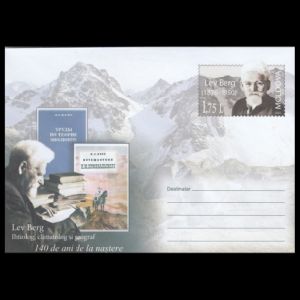 |
 |
|
Notes:
[P1] Lev Semyonovich Berg (March 14, 1876, Bender – December 24, 1950) was a leading Soviet geographer, biologist and ichthyologist who served as President of the Soviet Geographical Society between 1940 and 1950.
He also developed his own evolutionary theory (Nomogenesis) as opposed to the theories of Darwin and Lamarck.
For more details, please go here.
[P2] 100th anniversary of the Russian Paleontological Society.
Acknowledgements:
Many thanks to Dr. Peter Voice from Department of Geological and Environmental Sciences, Western Michigan University, for the draft page review and his very valuable comments.
| <<2017 | index | 2015>> |